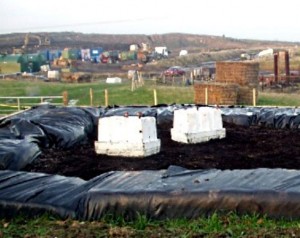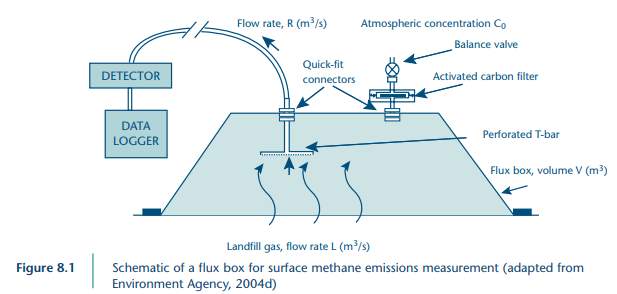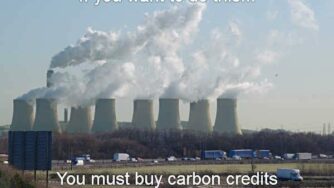Methane flux boxes are a tool used to detect the flow (leakage) of landfill gas (methane) through landfill gas restoration capping layers.

The UK Environment Agency may require that the landfill gas methane emissions from a landfill restoration cap are monitored regularly. This is required so that areas where excess gas might be escaping, can be found, and the leak(s) repaired. Many people who carry out methane monitoring and emissions analysis of this type use methane flux boxes as part of their tool box of methods to do this.
In the UK Flame Ionization Detectors (FIDs) are frequently used to measure gas concentrations close to the surface in order to detect leaks. A typical FID survey involves the monitoring technician walking along predetermined lines, monitoring the gas concentration continuously. The method is mostly suitable for the measurement of specific point emissions and remains the most appropriate method for identifying defects in the cap.

“Flux box monitoring of methane emissions from the surface of permitted or licensed landfill sites is of growing interest to site operators.”
The monitoring of emissions through a landfill cap has two stages.
Initially, a simple survey demonstrates whether there are inadequacies in the gas containment and collection system. Only when these deficiencies have been located and remedied such that the concentration of gas above the surface is low is it appropriate to begin a quantitative survey of surface flux.
Subsequently, the flux of methane emitted through the intact cap is measured at a number of representative points using an array of flux boxes. From these individual measurements, the average flux from the capped zones is calculated. This identifies where the gas flux exceeds an emission standard set by the Environment Agency. via www.scienco.com
FID with Flux Box Methods
Methane Flux boxes can be used to measure the flow of methane from a surface, i.e. the rate of change in emission concentration over time. They are used to produce flux box surveys, the objective of which is to quantify the total release of methane from the surveyed area.
There are two different types of methane flux boxes available to do this, the static closed chamber and the dynamic closed chamber, and both are known as methane flux boxes.
Whichever type is used, the box is placed onto the ground open side down with the open side temporarily sealed to the ground. The concentration of methane within the box is measured at short time intervals over a period of up to an hour. Once the data have been collected the methane flux is obtained by assessing the rate in increase in concentration over time.
This system is very simple and straightforward to perform and the accuracy is simply a function of the number of data points as well as being fairly cheap. Large numbers of monitoring points are needed.
Methane flux boxes are used to carry out flux box surveys, and are currently used in the UK for determining emissions from capped areas of landfill sites.
Using Methane Flux Boxes
The flux box method best at measuring low landfill gas fluxes and thus is suited to measuring capped landfill site methane emissions. It is not practical for use on working operational areas of the landfill.
Taking measurement at a lot of different locations is very time consuming as well as labour intensive. It is therefore not an ideal method for use on the current size of landfill sites.
Methane flux box based landfill gas emission monitoring must be done by technicians that understand the limitations of the technique, otherwise large errors are possible. Heating from solar warming or cooling by wind chill can lead to plus or minus 100% in measurement error.
Similarly, waterlogged ground or high wind speeds can change the measured flux at methane flux boxes by similar amounts. A typical methane flux box survey takes two to three weeks work, or more by a technician and an assistant, plus data analysis costs.
We hope that this has assisted you by explaining the purpose of methane flux boxes. Contact Landfill Systems for assistance with landfill monitoring.
Trace Gases in Landfill Gas from a Typical United Kingdom Municipal Solid Waste Landfill
Trace gases in UK landfill gas include a mix of VOCs, hydrogen sulfide, nitrogen, and others. These gases arise from the breakdown of organic waste and microbial actions. Over 500 trace components have been identified, including hydrogen sulfide, vinyl chloride, carbon disulfide, and BTEX compounds…
Gas Monitoring at Landfills – What To Monitor, Collect and Analyse The Data
Got strange smells drifting from your landfill? Worried about gas creeping into nearby homes? Gas monitoring at landfills isn't just about bad odours. It's about keeping people safe and meeting tough rules. Every bit of rubbish that breaks down underground releases gases that can explode or harm the environment if nobody's monitoring what's happening and […]
Landfill Gas Monitoring Procedures Methods and Guide
Landfill gas (LFG) monitoring procedures involve routine, site-specific procedures to detect gas leaks and ensure operational compliance, including monitoring methane, carbon dioxide, and other trace gases using portable instruments and fixed systems. Read on for our explanation of good practice procedures that include wellhead monitoring for oxygen, nitrogen, and carbon monoxide, perimeter monitoring for ambient […]
Best Portable Landfill Gas Analyzer Reviews & Comparison
Landfill gas monitoring is critical for health, safety, and compliance. A top-notch portable analyzer detects harmful gases in real-time, safeguarding workers and the environment. As regulations tighten, reliable equipment becomes essential for avoiding fines and mitigating risks associated with gas emissions from decomposing waste…









Looks pretty basic. Larger surface area surely needed for consistent results?
The current Guidance issued by the Environment Agency (based on research by the Department of the Environment in 1995) recommends the use of flux boxes to quantify the emissions from capped areas. Since the 1990s, new techniques have been developed, but they have not been standardised or independently evaluated for their suitability or practicality on UK landfill sites. See the report at: Review of landfill surface monitoring.
How many of these flux boxes will I need, and where to put them?